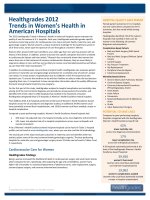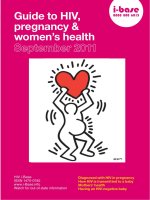Jeff nippard + stephanie buttermore intermediate to advanced women s specialization program
Bạn đang xem bản rút gọn của tài liệu. Xem và tải ngay bản đầy đủ của tài liệu tại đây (11.13 MB, 89 trang )
INTERMEDIATE TO ADVANCED
WOMEN’S
SPECIALIZATION
PROGRAM
STEPHANIE BUTTERMORE
JEFF NIPPARD
INTERMEDIATE TO ADVANCED
WOMEN’S
SPECIALIZATION
PROGRAM
STEPHANIE BUTTERMORE
JEFF NIPPARD
TABLE OF CONTENTS
ABOUT STEPHANIE
4
ABOUT JEFF
6
KEY TERMS
8
OUR GOAL
10
ANATOMY
13
FAQ
24
WARM UP
29
PROGRAM - BLOCK 1
31
PROGRAM - BLOCK 2
44
PROGRAM EXPLAINED
55
TECHNIQUE
59
TRAINING VARIABLES
61
EXERCISE SELECTION
70
SUBSTITUTION EXERCISES
73
VIDEO DEMONSTRATIONS
74
REFERENCES
78
DISCLAIMERS
83
ABOUT STEPHANIE
Stephanie Buttermore is a PhD who has transitioned from the world of academia for
a world of sharing her life and passion for the things she loves. Using her YouTube
and social media platforms, she entertains, and most importantly, educates on the
scientific principles of training and nutrition, blending her years of reading and writing
scientific literature with her passion for exercise and fitness.
EDUCATION:
• BS Micro/Molecular Biology University of Central Florida
• MS Medical Sciences, Women’s Health, University of South Florida
• MS Medical Sciences, Pathology & Cell Biology, University of South Florida
• PhD Biomedical Sciences, Pathology & Cell Biology, University of South Florida
W OMEN’S SPECIALIZ ATION PROGR AM
4
RESEARCH BACKGROUND
Dr. Buttermore’s doctoral research focused primarily on early detection screening
markers of ovarian cancer (OC) and the molecular mechanisms driving OC. Through
her work, she discovered that a protein called Receptor for Hyaluronan Mediated
Motility (RHAMM) was up regulated in OC cell lines, OC tissue and OC patient urine.
She demonstrated that RHAMM could be used in conjunction with other screening
modalities as a viable early detection urinary screening marker (patent).
W OMEN’S SPECIALIZ ATION PROGR AM
5
ABOUT JEFF
Jeff is a professional drug-free bodybuilder and powerlifter. Through his informative
and entertaining Youtube channel which has gathered a fan-base of over 700,000
subscribers, Jeff aims to share the knowledge he has gathered through university
education and field experience with others who are passionate about the science
behind building muscle, losing fat and getting healthier.
He earned the title of Mr. Junior Canada for natural bodybuilding in 2012 and as a
powerlifter, Jeff held the Canadian national record for the bench press in 2014. As a
powerlifter, Jeff has claimed a 502 lb squat, 336 lb bench press and a 518 lb deadlift
with an all time best Wilks score of 446.
With a Bachelor of Science degree in biochemistry, Jeff has gathered the requisite
scientific knowledge to compliment his practical experience acquired through training
and coaching. Jeff has coached women’s bikini and men’s bodybuilding national
W OMEN’S SPECIALIZ ATION PROGR AM
6
and provincial champions, professional natural bodybuilders and nationally and IPF
Worlds qualified raw powerlifters. He has presented seminars on Block Periodization,
concurrent training and nutrition and training for natural bodybuilding in academic
settings including the 2014 Online Fitness Summit and at the University of Iowa. He
has aspirations of completing a PhD in exercise science or a related field.
Jeff currently lives in Kelowna, Canada where he is producing informative YouTube
videos and podcasts while preparing for his next competition season in natural
bodybuilding in 2019.
W OMEN’S SPECIALIZ ATION PROGR AM
7
KEY TERMS
AMRAP: As many reps as possible (with good form). Often performed as a test to
determine max strength
Concentric: The contracting (“positive”) aspect of the lift
DB: Dumbbell
Eccentric: The lowering (“negative”) aspect of the lift
Effort: How hard you are pushing the set relative to failure. Measured with RPE or
%1RM
Frequency: How often you directly train a given muscle per 7 days
Hypertrophy: The growth of (muscle) tissue
Intensity: Effort and load
W OMEN’S SPECIALIZ ATION PROGR AM
8
Load: The weight of the external resistance
LSRPE: Last set RPE
Periodization: The organization of training over time
Primary exercise: Main heavy compound movements that involve a large muscle mass
(for example: squats, bench presses and deadlifts)
Progressive Overload: The gradual increase of stress placed upon the body during
exercise training. In training contexts, this generally involves progressively increasing
some lifting parameter over time (usually weight or reps)
ROM: Range of motion
RPE: Rate of perceived exertion. A measure of how difficult a set was on a 1-10 scale,
with 10 meaning muscular failure was achieved.
Secondary exercise: Compound exercises which involve less muscle mass (for
example: cable rows, lunges, hip thrusts, military presses, pull-ups, etc.)
Tempo: The speed at which the lift occurs.
Tertiary exercise: Isolation movements involving only one joint and primarily targeting
a single muscle – these are usually used to isolate a specific, smaller muscle or to
generate metabolic stress
Volume: Total amount of work performed. Usually approximated as sets x reps x load
W OMEN’S SPECIALIZ ATION PROGR AM
9
OUR GOAL
The primary goal of this program is to maximize overall muscular development and
shape for women in the intermediate to advanced stage of physique development,
with a special focus on glutes, shoulders, abs and back hypertrophy. The secondary
goal of this program is to increase overall strength on fundamental compound
movements that involve large muscle masses.
WHO THIS PROGRAM IS FOR
Intermediate to advanced lifters.
It’s difficult to pin down exactly what “intermediate” or “advanced” means in terms
of a specific training age due to the fact that training years in the gym are not equal
across individuals. For example, some women may have spent 10 years training in
the gym, but that time may only actually be “worth” 1 or 2 years if they’ve spent
the majority of their time just going through the motions without focus or direction.
W OMEN’S SPECIALIZ ATION PROGR AM
10
But as a general guide, if you’ve been training for at least 1-3 years, with a generally
serious approach toward training, you will benefit from this program.
ABOUT THIS PROGRAM
Before we dive into the nuts and bolts of the program itself, it’s important to first
make it clear what this training manual is intended to accomplish. This program is
divided into two 8-week training blocks, each with their own specific aims.
BLOCK 1
Block 1 focuses on two main goals:
1. Development of a huge work capacity and high volume tolerance. This work
capacity will set us up for success in Block 2 of the program, where volume is
decreased as intensity (effort) is increased.
2. Getting accustomed to a large exercise variation. Varying exercises will keep
training fun and challenging, while working different segments of different
muscles through varying strength curves.
BLOCK 2
Block 2 focuses two main goals:
1. Recovery. Block 2 begins with a deload week to emphasize recovery leading into
the most psychologically and physically demanding phase of the program.
2. Increased Intensity of Effort. Unlike Block 1 (which will require a degree of
restraint and special attention to careful execution), the main idea with Block 2
is a high degree of effort, by taking many sets closer to failure. Now that you
have mastered technique on a large variety of exercises and built a volume
tolerance it is time to increase intensity and set some PRs!
W OMEN’S SPECIALIZ ATION PROGR AM
11
ANATOMY
FUNCTIONAL ANATOMY
It’s important to understand the functional anatomy and biomechanics of the
main muscles we’ll be targeting before we can understand how to best train them.
Functional anatomy determines what muscles can do. There are two things to
consider when looking at a muscle’s functional anatomy – origin and insertion.
Muscles attach to bone by tendons from at least two points. The origin is the fixed
attachment which does not move and the insertion is the attachment which moves
closer to the origin when a muscle contracts. This contracting phase, referred to as
the concentric phase (known as the “positive” phase), is normally followed by the
eccentric phase (lowering the weight – also known as the “negative” phase).
W OMEN’S SPECIALIZ ATION PROGR AM
12
Figure 1A: The Main Posterior Muscles
Figure 1B: The Main Anterior Muscles
W OMEN’S SPECIALIZ ATION PROGR AM
13
QUADRICEPS: The quadriceps (“quads” for
short) are comprised of four muscles, often
referred to as “heads”: the vastus lateralis
(“quad sweep”), vastus medialis (“tear
drop”), rectus femoris (the middle portion
of your upper thigh), and vastus intermedius
(which runs underneath rectus femoris). The
quads act to extend the knee, taking the leg
from a bent position to a straight position.
Each muscle of the quad has its own unique
insertion which we won’t worry about too
much here. Just remember that the main
action of the quads is to extend (straighten)
the knee.
ORIGIN: The vasti muscles originate on the
body of femur (“thigh bone”). The rectus
femoris originates on the illium of the “hip
bone”
INSERTION: Tibial tuberosity
EXERCISEs: Back squat, front squat, walking
lunge, deficit curtsy lunge, deficit Bulgarian
split squat
Figure 2: Quadriceps Anatomy
W OMEN’S SPECIALIZ ATION PROGR AM
14
HAMSTRINGS: The hamstrings are actually a
complex of four muscles: semimembranosus,
semitendinosus, and biceps femoris
(which consists of a long head and a short
head). The hamstrings collectively act
to
both flex the knee (take the leg from a
straightened position to a bent position, as in
a leg curl) and extend the hip (pushing your
hips forward, as in a deadlift).
ORIGIN: The semitendinosus,
semimembranosus, and long head of the
biceps femoris originate on the ischial
tuberosity. The short head of the biceps
femoris originates on the linea aspera.
INSERTION: The semitendinosus and
semimembranosus both insert on the tibia,
while both the long and short heads of the
biceps femoris insert at the fibula.
EXERCISES: Deadlift, Romanian deadlift,
seated leg curl, bodyweight reverse
hyperextension, 45° hyperextension,
eccentric-accentuated lying leg curl, swiss
ball leg curl
W OMEN’S SPECIALIZ ATION PROGR AM
Figure 3: Hamstrings Anatomy
15
GLUTEALS: The gluteals (or “glutes”) are also a complex of muscles consisting of the
gluteus maximus, gluteus medius, and gluteus minimus. As the name suggests, the
gluteus maximus is the largest of the three, followed by the gluteus medius, and the
smallest gluteus minimus. The gluteus maximus has multiple origins including the
pelvis, sacrum, coccyx, and thoracolumbar fascia and multiple insertions including
the upper femur and IT band. Because of this, it is able to perform a wide variety of
functions, but primarily:
- hip extension (push your hips forward)
- hip abduction (move your thigh away from the midline)
- hip external rotation (rotating your thigh bone outwards)
- posterior pelvic tilt (tucking your butt “in”)
The smaller glute medius still occupies a hefty portion
of the rear hip musculature and functions primarily
as a stabilizer during dynamic movement and as a hip
abductor. It originates on the pelvis and inserts on the
femur. It is most effectively trained with exercises that
require a high degree of stability, especially unilateral
movements such as walking lunges, and exercises that
train hip abduction, such as machine hip abductions.
ORIGIN: The gluteus maximus, medius, and minimus
Figure 4: Gluteals Anatomy
originate on the ilium.
INSERTION: The gluteus maximus and gluteus minimus insert to the iliotibial tract
(IT band) and the gluteal tuberosity on the femur. The gluteus medius inserts to the
greater trochanter on the femur.
EXERCISES: Hip thrust, back squat, cable standing glute kickback, seated hip
abduction, deadlift, front squat, knee-banded hip thrust, lateral band walk, machine
seated hip abduction, deficit Bulgarian split squat, band seated hip abduction,
W OMEN’S SPECIALIZ ATION PROGR AM
16
PECTORALIS: There are
two pectoralis muscles
(pecs for short) located
on your chest: the
pectoralis major and
the pectoralis minor.
The pectoralis major
can be divided into two
heads: the clavicular
head or “upper chest”
(which originates at the
clavicle) and the sternal
head or “lower chest”
(which originates at the
Figure 5: Pectoral Anatomy
sternum). The pecs act to
adduct the upper arm (bring the upper arm across the body), and to internally rotate
the shoulder joint. The clavicular fibers also aid in shoulder flexion (raising your upper
arm up), but the sternal fibers do not.
ORIGIN: The pectoralis major originates on the sternum and clavicle. The pectoralis
minor originates on the 3rd-5th ribs.
INSERTION: The pectoralis major inserts on the humerus. The pectoralis minor inserts
to the coracoid process (front of your shoulder).
EXERCISES: Dumbbell standing shoulder press, close-grip push-up, dumbbell incline
press, machine shoulder press
W OMEN’S SPECIALIZ ATION PROGR AM
17
BACK: The back is comprised
of a massive web of muscles,
so for the sake of simplicity
we will only look at the
largest back muscles. The
latissimus dorsi (lats for
short) is a big muscle which
runs from just underneath
your arm pit all the way
down to the bottom of your
back. The lats primarily act
to extend the shoulder (bring
your upper arm downward)
and adduct the shoulder
(moving your elbows
towards your mid back).
The trapezius (traps for
short), is another large
muscle running from the
base of the skull down to the
middle of your inner back.
When people think about
the traps, they tend to only
Figure 6: Latissimus Dorsi Anatomy
think of the upper fibers, but the middle and lower fibers take up a very large surface
area as well. The traps act to elevate the scapulae (shrugging your shoulders), retract
the scapulae (pull the shoulder blades back), and extend the shoulder (pull your arms
backward when your elbows are raised).
W OMEN’S SPECIALIZ ATION PROGR AM
18
LATS:
ORIGIN: Illiac crest and
thoracolumnar fascia
INSERTION: Humerus
EXERCISES: Narrow neutral-grip
pulldown, cable seated row, supinated
pulldown, chest-supported T-bar
row, pronated pulldown, single-arm
pulldown, Hammer Strength machine
row
TRAPS:
ORIGIN: Occipital bone (upper traps),
corresponding supraspinous ligaments
for the mid and lower traps
INSERTION: nuchal ligament
EXERCISES: Cable seated row,
chest-supported T-bar row, Hammer
Figure 7: Trapezius Anatomy
Strength machine row, dumbbell
lateral raise, dumbbell rear delt raise, seated face pull, cable reverse fly, high-to-low
face pull, reverse pec deck, prone trap raise
W OMEN’S SPECIALIZ ATION PROGR AM
19
BICEPS: The biceps brachii are a two-headed muscle
containing a long head and a short head. They
collectively act to flex the elbows (bring the elbow
from a straightened position to a bent position), and
supinate the wrist (twist the pinky upwards). The
brachialis, which runs underneath the biceps brachii,
is also a strong elbow flexor
Figure 8: Biceps Anatomy
ORIGIN: coracoid process, supraglenoid tubercle
Insertion: Radial tuberosity
EXERCISES: Narrow neutral-grip pulldown, single-arm cable curl, supinated pulldown,
hammer curl
TRICEPS: The triceps lie on the back of your upper
arm and are made up of three heads: a long head,
a medial head, and a lateral head. The triceps
collectively act to extend the elbow (bring the
elbows from a bent position to a straightened
position).
ORIGIN: Infraglenoid tubercle, radial groove
Insertion: Olecranon process on ulna
Figure 9: Triceps Anatomy
EXERCISES: Dumbbell shoulder press, close-grip push-up, dumbbell skull crusher,
dumbbell incline press, machine shoulder press, cable rope tricep extension
W OMEN’S SPECIALIZ ATION PROGR AM
20
DELTOIDS: The deltoids (or delts for
short) are comprised of 3 different heads,
the anterior deltoid (the “front” delt), the
lateral deltoid (also known as the “middle”
delt, and often mistakenly called the
“medial delt”), and the posterior delt (also
known as the “rear” delt). The anterior
delt acts to flex the shoulder (raise the
arm up), the lateral delt acts to abduct
the upper arm (raise your upper arm out
directly to your sides), and the posterior
delt acts to abduct the shoulder (pull
the shoulder back when the elbows are
raised).
ORIGIN: Clavicle, acromion process, spine
of scapula
Figure 10: Deltoid Anatomy
INSERTION: deltoid tuberosity of humerus
EXERCISES: Dumbbell shoulder press, close-grip push-up, dumbbell lateral raise,
dumbbell rear delt raise, seated face pull, dumbbell incline press, cable lateral raise,
cable reverse fly, high-to-low face pull, constant-tension dumbbell lateral raise,
dumbbell front raise
W OMEN’S SPECIALIZ ATION PROGR AM
21
Figure 11: Abdominal Anatomy
ABS: The abs are a huge web containing many muscles which all have a similar
function. When talking about the abs, we are typically referring to the rectus
abdominis – the “6-pack”. The rectus abdominis acts to flex the spine, rotate the
torso, and resist spinal extension (prevent your lower back from arching inwards).
ORIGIN: Crest of pubis
INSERTION: Xiphoid process
EXERCISES: Bicycle crunch, hollow body hold, Russian twist, hanging leg raise
W OMEN’S SPECIALIZ ATION PROGR AM
22
CALVES: The calves are a complex consisting
of two muscles – the gastrocnemius (or gastroc
for short) and the soleus. The gastrocnemius
is
the big muscle underneath the back of your knee
and the soleus is a smaller, flatter muscle which runs
underneath the gastroc down to your ankle. Both the
gastroc and soleus act to plantarflex the ankle (point
your toes down).
Origin: Lateral and medial condyle of femur
INSERTION: tendo calcaneus
EXERCISE: Standing calf raise, seated calf raise
Figure 12: Anatomy of the Calf Muscles
W OMEN’S SPECIALIZ ATION PROGR AM
23
F.A.Q.
1: How do I know if I am progressing?
A: You want to think of this journey as a marathon, not a sprint. It can be difficult to
accurately determine if you are making visual progress day-to-day or even week-toweek. Taking physique progress photos every 4-6 weeks and comparing them side
by side is a good way to detect visual differences that you simply wouldn’t notice
in the mirror. But ultimately, because of the relationship between strength gain and
muscle gain, the main metric you want to use for tracking your progress is strength. If
you’re getting stronger, while using good technique, you’re progressing. It is strongly
recommended to log every workout either in writing (print the program out or use a
separate notebook) or in an app, so you don’t have to rely on memory to keep track of
personal strength records. Taking body measurements a few times a year can also be
helpful but simply focusing on steady strength progression will be your best proxy for
determining muscular progress.
W OMEN’S SPECIALIZ ATION PROGR AM
24
2. How do you use progressive overload?
See “Progression” on page 67.
3. What does RPE mean?
See RPE-Based exercises on page 64.
4. Should I eat in a caloric deficit, maintenance, or surplus while running this
program?
A: Eating in a slight caloric surplus will yield the best results and best recovery,
however, if your main goal is fat loss, eating in a caloric deficit will be necessary.
As a beginner, you can continue to make strength and size progress while in a
moderate caloric deficit and achieve body recomposition (lose fat and build muscle
at the same time) if protein intake is sufficient (0.8-1g/lb bodyweight as a ballpark).
As an intermediate-advanced level trainee, the likelihood of achieving substantial
body recomposition is smaller, but still possible. So, in all, a caloric surplus is
recommended for optimal progress, but some progress can still occur at caloric
maintenance and even in a caloric deficit.
5. I am not getting sore from my workouts. Is the program not working?
A: Muscle soreness is largely attributed to eccentric contractions [1] and
contractions at long muscle lengths [2]. Delayed onset muscle soreness (DOMS)
isn’t required for hypertrophy to occur, but the associated muscle damage might play
a role in hypertrophy [3]. With that said, the main goal of this program is to build
muscle and strength, not to get you feeling sore. In fact, reduced soreness over time
indicates that your body is adapting and recovering, which is actually a good thing
for continued progress.
6. I am getting very sore from my workouts. Should I skip the gym until I am not sore?
A: You may experience increased soreness when you first begin the program because
it is presenting a new stress to your body. Foam rolling can help reduce DOMS
W OMEN’S SPECIALIZ ATION PROGR AM
25









